The SSD Relapse: Understanding and Choosing the Best SSD
by Anand Lal Shimpi on August 30, 2009 12:00 AM EST- Posted in
- Storage
Why SSDs Care About What You Write: Fragmentation & Write Combining
PC Perspective's Allyn Malventano is a smart dude, just read one of his articles to figure that out. He pieced together a big aspect of how the X25-M worked on his own, a major key to how to improve SSD performance.
You'll remember from the Anthology that SSDs get their high performance by being able to write to multiple flash die across multiple channels in parallel. This works very well for very large files since you can easily split the reads and writes across multiple die/channels.
Here we go to write a 128KB file, it's split up and written across multiple channels in our tiny mock SSD:
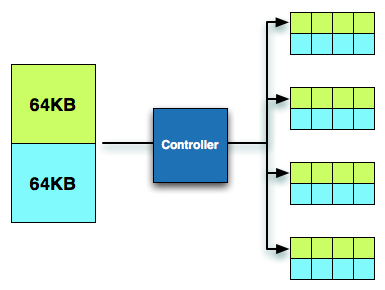
When we go to read the file, it's read across multiple channels and performance is once again, excellent.
Remember what we talked about before however: small file random read/write performance is actually what ends up being slowest on hard drives. It's what often happens on a PC and thus we run into a problem when performing such an IO. Here we go to write a 4KB file. The smallest size we can write is 4KB and thus it's not split up at all, it can only be written to a single channel:
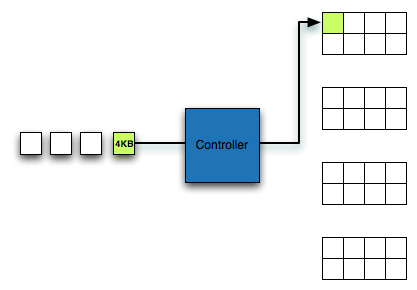
As Alyn discovered, Intel and other manufacturers get around this issue by combining small writes into larger groups. Random writes rarely happen in a separated manner, they come in bursts with many at a time. A write combining controller will take a group of 4KB writes, arrange them in parallel, and then write them together at the same time.
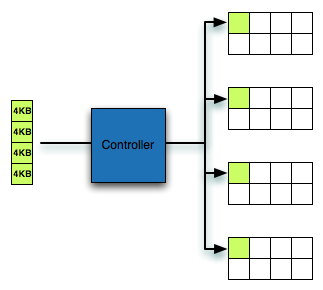
This does wonders for improving random small file write performance, as everything completes as fast as a larger sequential write would. What it hurts is what happens when you overwrite data.
In the first example where we wrote a 128KB file, look what happens if we delete the file:
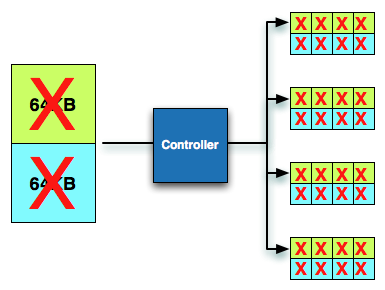
Entire blocks are invalidated. Every single LBA in these blocks will come back invalid and can quickly be cleaned.
Look at what happens in the second example. These 4KB fragments are unrelated, so when one is overwritten, the rest aren't. A few deletes and now we're left with this sort of a situation:
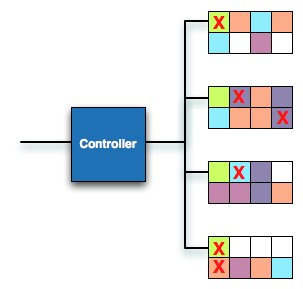
Ugh. These fragmented blocks are a pain to deal with. Try to write to it now and you have to do a read-modify-write. Without TRIM support, nearly every write to these blocks will require a read-modify-write and send write amplification through the roof. This is the downside of write combining.
Intel's controller does its best to recover from these situations. That's why its used random write performance is still very good. Samsung's controller isn't very good at recovering from these situations.
Now you can see why performing a sequential write over the span of the drive fixes a fragmented drive. It turns the overly fragmented case into one that's easy to deal with, hooray. You can also see why SSD degradation happens over time. You don't spend all day writing large sequential files to your disk. Instead you write a combination of random and sequential, large and small files to the disk.










295 Comments
View All Comments
IPL - Monday, August 31, 2009 - link
I first started reading anandtech when I got seriously interested in SSDs and honestly, you write the best SSD articles around! Thank you for all the help you gave me in deciding which SSD to buy.I ordered online the new G2 last week and should be getting it in a few days. I live in Greece and the re-launched G2 has been available here for about a week now.
I am planning on replacing the HDD on my Feb 08 Macbook Pro (last refresh pre-unibody) as soon as I get it. I am just a consumer with a little bit of knowledge on tech but not a pro at all. I just thought of asking all a few questions that I have pre-drive swapping.
1. Will TRIM be supported on macs? Any news if and when?
2. When then new TRIM firmware is out, do I have to just install the firmware or will I need to format everything and start from fresh in order to get it to work?
3. I have bought a 2,5'' SATA USB enclosure in order to put my G2 in there first, connect it to the laptop via the USB and install Snow Leopard from there. After I am done, I will remove the G2 from the enclosure, swap the drives and hopefully, everything will be working. Does this sound logical? I am worried about the h/w drivers to be honest.
Thanks in advance for your help. I will post some non-scientific time results as soon as get this done. Cant wait.
gstrickler - Monday, August 31, 2009 - link
The simplest way to swap the HD on most Mac OS machines is:1. Connect both the old and the new drive to the machine (internally or in an external USB or FireWire case).
2. Use Disk Utility (included in Mac OS X) to set the appropriate partitioning scheme (GUID for Intel based Macs, Apple Partition Scheme for PPC Macs) on the new drive.
3. Partition and format the new drive.
4. Use Carbon Copy Cloner (shareware) to clone the old drive to the new drive.
5. Try booting off the new drive. Note that PPC Macs can't boot from USB drives, but Intel based Macs can. All PPC and Intel Macs with a built-in FireWire port can boot from a FireWire drive.
6. If not already done, physically swap the drives to the desired locations, boot and set the preferred startup drive.
IPL - Tuesday, September 1, 2009 - link
Awesome, thanks for the help.I have checked Carbon Copy Cloner and it is already one of my options. Never tried it before but looked easy enough.
I havent decided yet which way I will do it (fresh install or clone existing drive) but I will make my mind up when everything is ready!
Anand Lal Shimpi - Monday, August 31, 2009 - link
Thank you for reading and saying such wonderful things, I really do appreciate it :)1) I don't believe TRIM is presently supported in Snow Leopard. I've heard that Apple may be working on it but I don't think it's there now.
2) From what I've seen, it should preserve your data. It's still worth backing up just in case something ridiculous happens.
3) What you're describing should work, although if I were you I'd just swap the drives and install. Hook your old drive up via USB and pull any data you need off of that.
Take care,
Anand
sunbear - Monday, August 31, 2009 - link
Another fantastic article. I just wanted to draw your attention to recent reports that the majority of currently available laptops (including the MacBookPro) are unable to support transfer rates greater than SATA-150 (http://www.hardmac.com/news/2009/06/16/new-macbook...">http://www.hardmac.com/news/2009/06/16/...imited-1....Since most laptops can't even use the full performance of these SSD's, do you have any recommendation regarding which one would be the best bang-for-the-buck to speed up a laptop?
Personally, I am interested in putting SSD's in a laptop not only for the speed improvements, but I'm also hoping that it reduces the amount of heat that my laptop will put out so that I can finally find a laptop that you can use comfortably on your lap!
Incidentally, it would be really great if laptop reviewers checked to see if they could comfortably work with a laptop at full load on their lap as a standard test.
Anand Lal Shimpi - Monday, August 31, 2009 - link
Even on a SATA-150 interface, you're generally only going to be limiting your sequential read speed and perhaps your sequential write speed a bit. Random read/write speeds don't really go above 60MB/s so you're fine there.They recommendations remain the same; Intel at the top end, anything Indilinx MLC to save a bit. If anything, a SATA-150 interface makes the Intel drive look a bit better since its 80MB/s sequential write limit isn't as embarrassing :)
Take care,
Anand
Dobs - Monday, August 31, 2009 - link
I hope Seagate / Western Digital etc. bring even more innovation / competition in SSD's next year... and not just Enterprise products.And one thing I don't fully understand is why there aren't more dedicated 3.5" drives. Patriot has the adapter but what about the rest??? No money in desktops anymore???
Anand Lal Shimpi - Monday, August 31, 2009 - link
OCZ is making a 3.5" Vertex drive, waiting on it for review :)Take care,
Anand
kisjoink - Monday, August 31, 2009 - link
Now that the good performing SSDs are half the price of last year, I'd really like to see a 2xSSD in RAID 0 article!mgrmgr - Monday, August 31, 2009 - link
I second the request for a 2xSSD RAID-0 article...with specific discussions about which applications it benefits (Photoshop?) and which ones it doesn't.Before October 22nd when I buy a new Win7 computer? Please. :-)